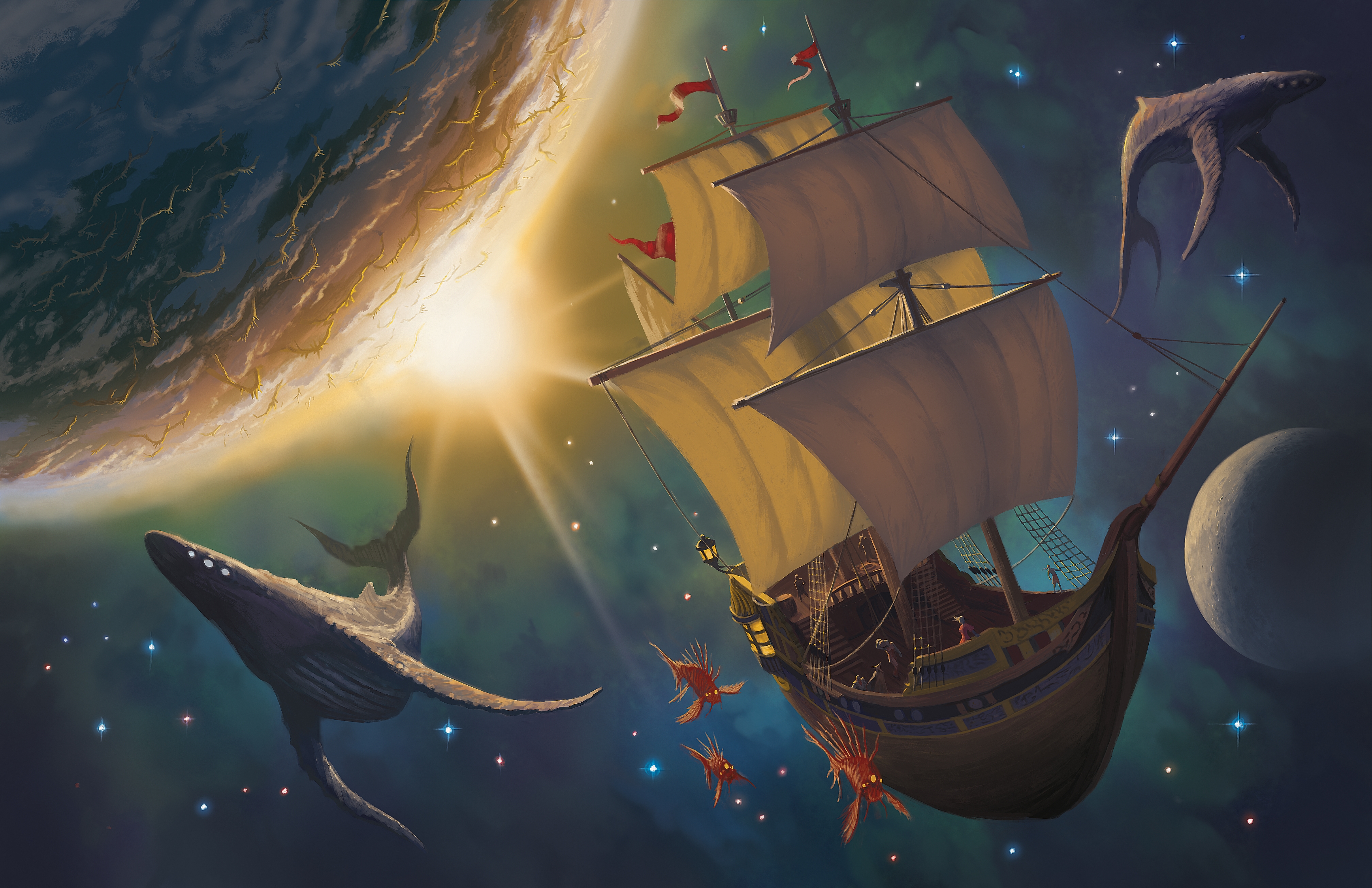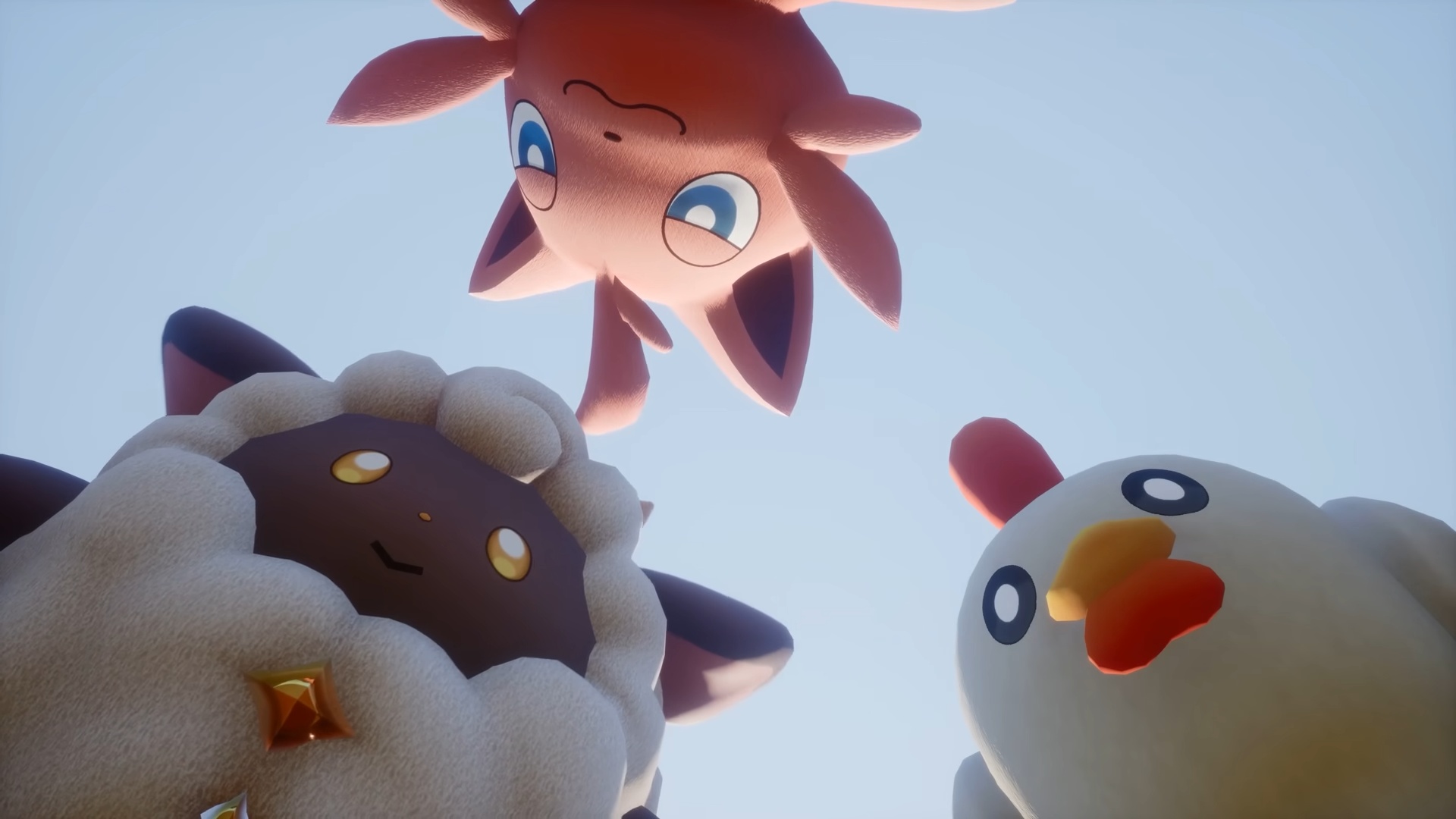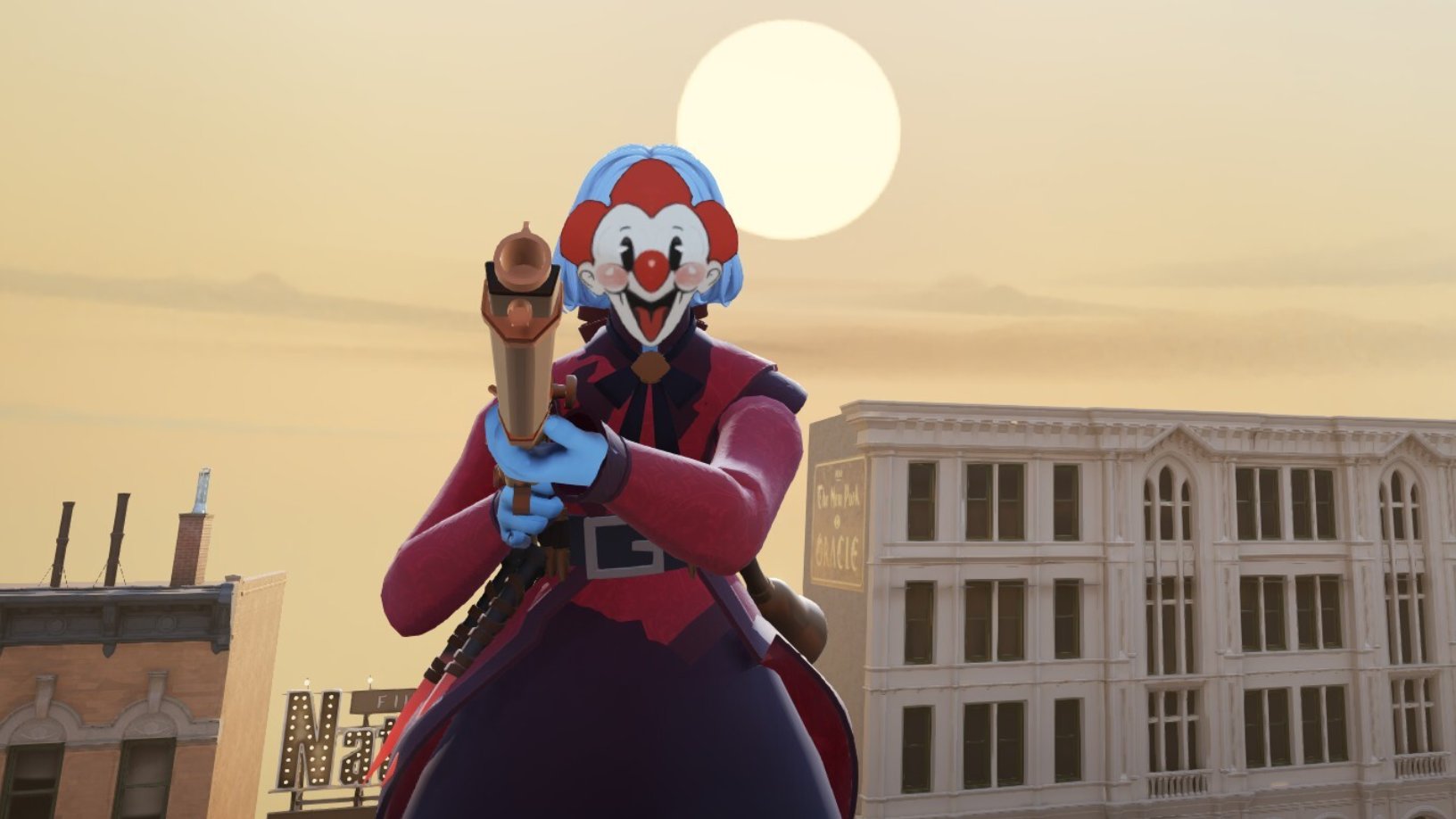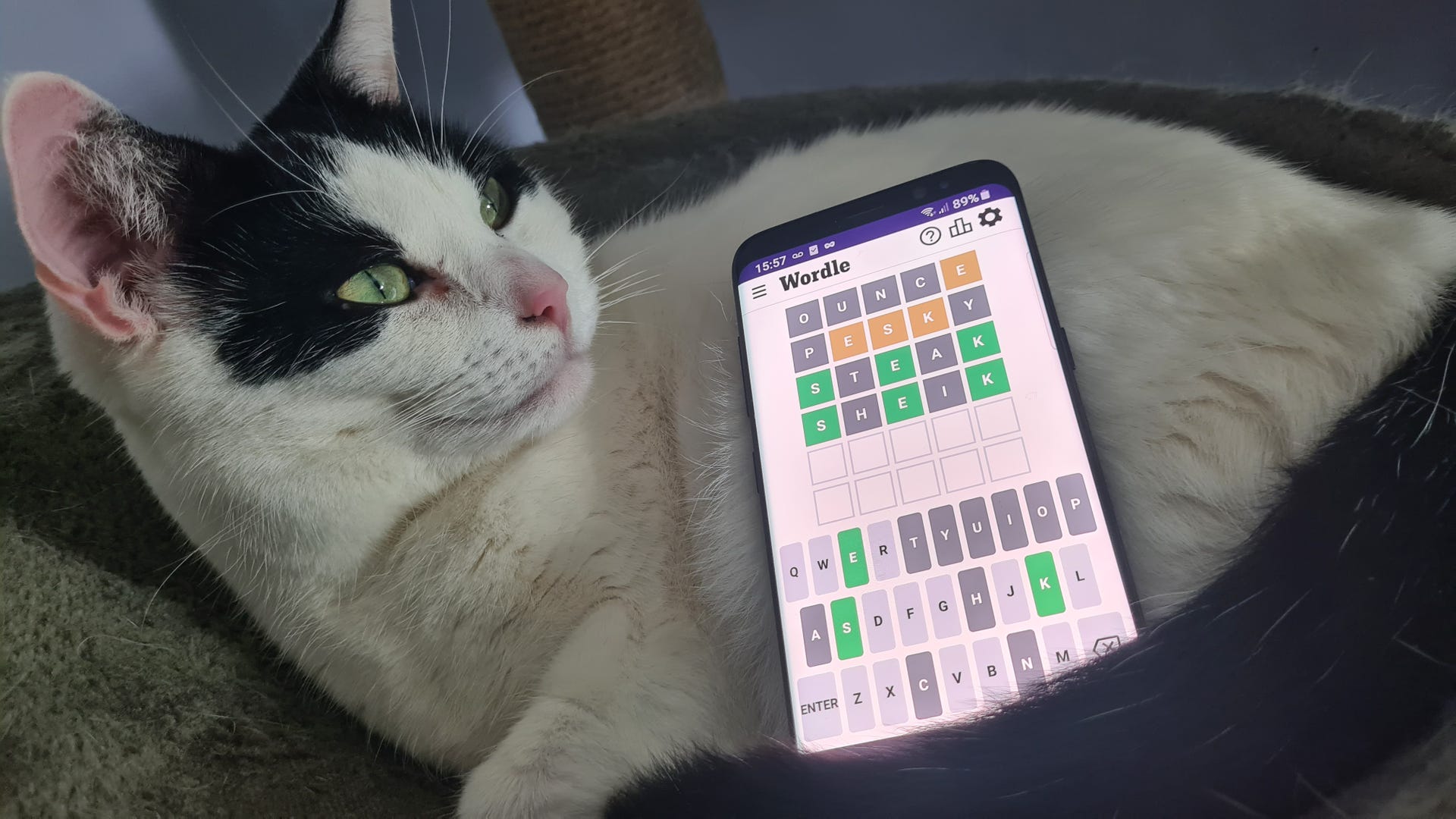
The tabletop RPG revisits the swashbuckling world of Wildspace.
“You have to mind the space guppies,” says Chris Perkins, senior story designer for Dungeons & Dragons.
He’s giving a press conference on the next D&D campaign setting, Spelljammer: Adventures in Space, showing us an illustration of a wizard with a magical air bubble around her head riding a flying carpet through the stars while a school of fish bob alongside. This picture is Spelljammer all over. It treats space the same way regular D&D treats the Middle Ages—a fine thing to draw inspiration from, but wouldn’t it be better with commonplace magic and hordes of odd creatures?
One thing this illustration is missing is a spelljammer. Interplanetary craft that might look like a ship from the Age of Sail, a deep sea creature, or a real big spider, they’re how most people get around in what’s called ‘Wildspace’. At least, the people without flying carpets.
“A lot of people do travel on ships,” Perkins says, “because ships have weapons and wizards and other things on board them. They’re very handy to have if a githyanki cruiser swoops down and starts attacking you, or a mind flayer nautiloid comes out of the mouth of a giant dead god and assails you.”
Before we get into the dead gods, let’s go back a little. The original version of Spelljammer was released in 1989. A campaign for the then-current AD&D 2nd edition rules, it gave players a way to travel between settings—whether a bridge between their own homebrew worlds or published ones like the Forgotten Realms, Greyhawk, and Dragonlance. It was also a setting of its own, with locations like an asteroid city called the Rock of Bral, so you could run an entire campaign without ever coming down.
That incarnation of Spelljammer only lasted until 1993. A bunch of related books were published in those years, supplements and adventures, as well as a comic and a videogame subtitled Pirates of Realmspace (sadly no longer available). Unfortunately, Spelljammer was one of way too many D&D settings available in the 1990s and never really found its audience. A video board game called WildSpace was canceled, though its glorious trailer survives.
Spelljammer has made cameos in the years and editions since, but this will be its first proper revival, with a three-book set made up of a rulebook (Astral Adventurer’s Guide), an adventure (Light of Xaryxis), and a monster manual (Boo’s Astral Menagerie). The last of those books features Minsc and his miniature giant space hamster companion Boo from Baldur’s Gate on its cover, riding a dragon through space while something explodes behind them.
The new Spelljammer’s visual identity brings to mind airbrushed pictures of wizards on the side of vans. There’s a lot of bright smears of blue and pink, space whales and nebulas. This is Wildspace, the place you find on the other side of your home planet’s atmosphere, and it’s not like space as we know it.
(Image credit: Wizards of the Coast)
Wildspace isn’t cold or dark. While there’s no oxygen, when you break atmosphere you bring an air envelope with you that will hopefully last long enough to reach the next breathable atmosphere. You also bring your own gravity plane, which explains why nobody floats off the deck of their ships. Oh, and it’s full of life, including whales and space guppies, who either don’t need to breathe or bring their own air envelopes with them. It’s an entire system of astrophysics that reinforces the idea this isn’t the universe we live in. Instead, it’s a place of pulp serial adventure inspired as much by Flash Gordon as Star Trek.
“Very rarely in Wildspace do you actually see the color black,” Perkins says. “We wanted it to be vibrant, partly because in the movie Flash Gordon, when Flash heads into space toward Mongo it’s very psychedelic. It was all done with watercolor paints poured into tanks, so everything was very bright. We were trying to emulate that feel here deliberately, so that it becomes clear visually that Spelljammer is not a science fiction setting. It’s a fantasy setting.”
(Image credit: Wizards of the Coast)
The old Spelljammer was never particularly serious either. Playful and goofy, it contained space hamsters, gnomish inventions powered by space hamsters running in wheels, gun-toting hippo people called giff, telepathic penguins called dohwar, and a disciplined army of space orcs called scro—which is just ‘orcs’ spelled backwards.
As the space hamster on the cover of Boo’s Astral Menagerie suggests, at least some of that tone remains in new Spelljammer, though that’s not all there is to it. “D&D has always run the gamut when it comes to playing with genres,” Perkins says. “Some D&D games are very serious, some are very dark. There’s horror D&D, there’s a lot of whimsy in D&D. Basically, my only goals or instructions in that regard was to just make Spelljammer feel like a D&D setting by making sure all those elements were present so that a DM could then choose what sort of fantasy Spelljammer game they want to run. If they want to do cosmic horror there are cosmic horror-type creatures in Boo’s Astral Menagerie, if they want to do something swashbuckling, campy, and whimsical there are creatures and elements along that line as well.”
And if they want to combine camp and horror, there are evil clowns explicitly based on the ones from 1988 movie Killer Klowns from Outer Space.
(Image credit: Wizards of the Coast)
It’s space, but not as we know it
Spelljammer’s 5E incarnation isn’t keeping everything. While gravity planes and air envelopes are still in, the Spelljammer of old also had a cosmology that combined ancient Greek astronomer Ptolemy’s hypothesis that the universe was made of nested spheres, 17th century theories about an element called phlogiston that was responsible for fire, and the belief gravity was caused by a substance known as aether—a belief Isaac Newton subscribed to, describing aether as “much rarer within the dense bodies of the Sun, stars, planets and comets, than in the empty celestial space between them”.
“There are a couple things that we did not bring forward,” Perkins says, “partly because they did not sync up well with where our cosmology currently stands. If you know the Spelljammer of old, the Spelljammer of 1989, there were things called crystal spheres and every planetary system was contained in a gigantic crystal sphere. When you get to the edge of your solar system, basically you slam into this crystal wall unless you find a way through it. Then there was this aether, this flammable aether was what separated different crystal spheres or different systems. If you did manage to get out of your crystal sphere, what you would find yourself in is a flammable aether with nothing in it.”
While the idea that stars were just lights on walls surrounding each system provided a convenient excuse for why the constellations seen from those worlds didn’t line up (without having them be too far apart to travel between), keeping them separate with a flammable soup called the Phlogiston was always a weird choice. It wasn’t an exciting medium to travel through. There wasn’t much in it or much to do there, and if you struck a match or cast a fireball, you’d explode.
(Image credit: Wizards of the Coast)
Its replacement is the Astral Sea, a way of visualizing the astral plane, the realm of thought and dream that player-characters traveled through back in the early days of D&D when plane shift spells or falling through a convenient vortex was how you brought your PC from one game to someone else’s.
“The very word ‘astral’ means ‘of the stars’,” explains Perkins, ‘and so when we were thinking about what to keep and what to change, we wanted to make Wildspace and the Astral Sea our media through which the characters will travel in this version of Spelljammer—just leaning into that idea that you are flying among the stars.”
The Astral Sea is a silvery blue plane, not quite as vivid as Wildspace. It contains portals to other realms, including the homes of the gods, but it’s also where gods go when they die, their immense corpses floating through the void. The githyanki, like Lae’zel from Baldur’s Gate 3, escaped their mind flayer masters to hide here, and it’s home to titanic predators called astral dreadnoughts, and more space whales. There’s a lot going on. Plus, as a realm of pure thought you don’t need to breathe, eat, or sleep, in the Astral Sea and can navigate by imagining where you want to go, unfurling the sails, and catching a psychic wind.
“It facilitates the kind of play and excitement that we want in a D&D game,” Perkins says. “Fun stuff can happen there, you can get to your destination quickly if the DM just wants to say, ‘and you’re there’. It’s got tremendous versatility and it opens up doorways to other parts of our multiverse, some of which we haven’t explored yet, but will in future product.”
(Image credit: Wizards of the Coast)
Adventure Time
Exploring the Astral Sea, and the rest of the setting, is the adventure Light of Xaryxis. It also introduces the unique physics for players who are new to it. “In the adventure characters go have this scene where they leave their world on a space galleon,” Perkins says, “and they have the experience of, ‘OK, I’m not flying off the deck of my ship, what’s going on here? Somebody explain this to me? I can breathe. Can somebody please explain that to me?’ Those things are expressly covered in the adventure in the situation that the characters find themselves. The rulebook also talks about these topics, but more in a general sense of ‘this is the way things are and this is how space works in D&D.'”
Discussing the inspiration for this adventure, Perkins gets up and goes to his bookshelf to fetch a collection of the complete Flash Gordon comic strips. “What I loved about those is they always tried to end each strip on a little mini-cliffhanger,” he says. “I thought, wouldn’t it be fun to try to build an adventure around that same kind of idea, where every session of play ends with a cliffhanger? The adventure is actually written with that in mind, so there are like 12 sessions of play in the 64-page adventure and each one either has a scripted cliffhanger, or basically ways for DMs to orchestrate their own cliffhanger. What I loved about that was the feeling that might create at the game table, the suspense of just hanging on a critical note and getting players excited about coming back for the next session.”
Though it’s not something the rulebooks normally cover, getting a group of players to come back week after week for every hours-long session is one of the hardest parts of RPGs. Most campaigns fizzle out rather than reaching a natural ending. Light of Xaryxis was designed with that in mind. “We estimate 12 sessions of play,” Perkins says, “which for us is actually a pretty short campaign, but the message we’re getting from our DMs is, ‘We love your long campaigns like Icewind Dale and Witchlight and Out of the Abyss and Curse of Strahd, but they take six months to 18 months to complete.’ That’s a long time commitment. Here we’re exploring the possibility of: You can finish this campaign in 12 sessions. You can have the glorious sensation of completing a campaign. Possibly for the first time in your life!”
(Image credit: Wizards of the Coast)
Spelljammer isn’t the only classic setting returning in 5th edition, with Dragonlance’s Krynn returning as well. The gothic horror world of Ravenloft has had a couple of books already, and Ghosts of Saltmarsh returned to Greyhawk. There are plenty of others still left to revisit, however, like fan-favorite Planescape.
“With 5th edition we have fully embraced the idea that our default setting is the multiverse,” Perkins says. “It’s not Greyhawk, it’s not Forgotten Realms, it’s not Krynn, it is the whole multiverse. In order to back that up we have an obligation to show as many parts of the multiverse as we can. I think that’s really our goal here with this product and others that we’ve released recently, and will release in the coming years, is to just give DMs and players glimpses at other corners of the multiverse.”
Spelljammer: Adventures in Space will be available in North America from August 16, and in other parts of the world after that.






